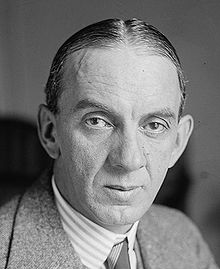- Manuel Gamio
-
Manuel Gamio (1883–1960) was a Mexican anthropologist, archaeologist, sociologist, and a leader of the indigenismo movement. He is often considered as the father of modern anthropological studies in Mexico.[1] He devised a well-known system for classifying the hunter-gatherers of Central America.
Contents
Education
Gamio was born in Mexico City, where he studied engineering at the School of Mining. However, at age 19 he left his studies to work on a family rubber plantation, where the states of Oaxaca, Veracruz and Puebla join. There he learned Nahuatl from the plantation workers and developed a strong interest in Mexico's indigenous cultures.[2]
He returned to study at the National Museum under Zélia Nuttall, who in 1909 sent him to study under Franz Boas at Columbia University.[3] There he earned a Ph.D. From Boas he adopted the cultural approach characteristic of the anthropology of the United States in the twentieth century.[4] Boas considered Gamio one of his best students.
Work in Mexico and Guatemala
He returned to Mexico in 1910 and the following year he was among the founders of the Escuela Internacional de Arqueología y Etnología Americana (International School of Archaeology and Ethnology of the Americas) in Mexico City, with funds obtained from Germany and the United States. Other individuals associated with the school included Eduard Seler, Alfred M. Tozzer and Boas. This was during the Mexican Revolution, and thus was a difficult time to establish new scientific institutions. Gamio was director of the school from 1916 through 1920, when it closed for lack of funds.
In 1911 he established a ceramic sequence for the Valley of Mexico based on earlier stratigraphic excavations at Azcapotzalco, Distrito Federal. Between 1913 and 1916 he was inspector general of archaeological monuments of the Mexican Ministry of Public Education. He performed field work at various places in the Valley of Mexico, including Copilco, Cuicuilco and the Templo Mayor (all in the Distrito Federal); Chalchihuites, Zacatecas; Yucatán; Ecuador and Miraflores, Guatemala. He was the first scientific investigator to explore Teotihuacan. A result of these investigations was the book La población del valle de Teotihuacan (The Population of the Valley of Teotihuacan), published in 1922. A revision of his Columbia thesis, this work is still an important source for ethnographic information on the northern zone of the State of Mexico. He also produced some documentary films. He estimated the maximum population of Teotihuacan at 300,000.[5] He criticized the Mexican census for classifying Spanish-speaking Indians as whites and those married by traditional rites as single.
Earlier, in 1916, he had published the important book Forjando patria: pro nacionalismo (Mexico City: Libreria de Porrúa Hermanos) (Forging a Fatherland), a treatise on cultural assimilation of indigenous Mexicans into the racially mixed society of the country. Other works in Spanish include Hacia un México nuevo (1935) and Consideraciones sobre el problema del indigenismo (1948).
In the 1920s he investigated the highlands of Guatemala, near the cities of Quiche, Huehuetenango and Quetzaltenango, concentrating on pottery styles. Due to the similarity of pottery from Guatemala and central Mexico, Gamio believed the latter area to be the original source of Mayan civilization. He hypothesized that some of the early natives of central Mexico abandoned that area in search of a place free of earthquakes and volcanos.[6]
Work in the United States
In 1925 he emigrated to the United States after denouncing corruption in the Mexican Ministry of Education. He concentrated on the subjects of migration and labor involving Mexicans in the United States, for the Social Science Research Council in Washington, D.C. Gamio published two books on this research — Mexican Immigration to the United States (1930) and The Mexican Immigrant: His Life Story (1931) — this time in English. These books have only recently been translated into Spanish for the use of present-day Mexican anthropologists and sociologists.[7]
He returned to Mexico in 1930, where he held various government positions, conducted sociological and applied anthropological investigations, and directed the Inter-American Indian Institute from its foundation in 1942 until his death in 1960.[8]
Notes
- ^ Gaillard (2004, p.257)
- ^ Gaillard (2004, p.257)
- ^ Gaillard (2004, pp.255,257)
- ^ Darnell (2001, p.323)
- ^ "Un siglo de éxitos de la arqueología mexicana"
- ^ "Ancient Mayas Studied Earthquakes; Sought Land Free From Them for Home", The Science News-Letter, September 18, 1926
- ^ Review of El inmigrante mexicano: la historia de su vida: Entrevistas completas, 1926–27, Migraciones Internacionales, vol. 2, no. 1, Jan.-June 2003, pp. 171–175
- ^ Gaillard (2004, p.257)
References
-
- Darnell, Regna (2001). Invisible Genealogies: A History of Americanist Anthropology. Critical studies in the history of anthropology series, vol. 1. Lincoln: University of Nebraska Press. ISBN 0-8032-1710-2. OCLC 44502297.
- Gaillard, Gérald (2004). The Routledge Dictionary of Anthropologists. Peter James Bowman (trans.) (English translation of Dictionnaire des ethnologues et des anthropologues [1997] ed.). London and New York: Routledge. ISBN 0-415-22825-5. OCLC 52288643.
- León-Portilla, Miguel (April 1962). "Manuel Gamio, 1883–1960". American Anthropologist (Arlington, VA: American Anthropological Association and affiliated societies) 64 (2): pp.356–366. doi:10.1525/aa.1962.64.2.02a00110. OCLC 1479294.
External links
- "Manuel Gamio" by Tony Tichnor, EMuseum at Minnesota State University, Mankato
Categories:- 1883 births
- 1960 deaths
- Mexican anthropologists
- Mexican archaeologists
- Mexican sociologists
- Mexican Mesoamericanists
- Mesoamerican archaeologists
- Mesoamerican anthropologists
- Aztec scholars
- 20th-century Mesoamericanists
Wikimedia Foundation. 2010.

